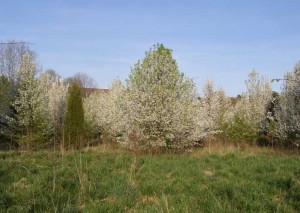Concerned about redbuds
By Ken Moore
Recently, I attended Janie and Stewart Bryan’s celebration of the annual flowering of their big redbud. On the short drive west of Carrboro, I was admiring all the redbuds growing naturally along the forest edges.
I reflected on how much I prefer the two-plus weeks of redbud flowering to that earlier, less-than-a-week flowering of the Bradford pears, that are ubiquitous in shopping malls and along residential streets. You may detect my annual Bradford pear tirade.
It’s been several years since I’ve seen the magnificent redbud gracing the corner of Janie’s and Stewart’s home; I had forgotten how impressive it is.
When I suggested that it must certainly rank up there with the state champion, we went to the computer to find out where the state champion redbud actually resides. (dfr.state.nc.us)
The currently listed champion eastern redbud, Cersis canadensis, is located in Forsyth County. And guess what? That champion may be in for a real challenge! The measurements (circumference, height and spread) of our local specimen seem to surpass those of the current champion. The statistics have been forwarded to the state-champion tree folks for an official determination.
I hope I can report a new champion sometime in the near future.
Meanwhile, just reflect back on what a magnificent redbud flowering season we continue to have, in spite of the recent summer heat wave. The mini-heat wave didn’t seem to alter redbud flowering, but it did hasten the emergence of dogwood leaves. The usual dazzling white of flowering dogwood, Cornus florida, is camouflaged this spring by the flush of fresh green foliage. However, even in its subdued form, the long period of dogwood flowering, overlapping with the redbud, and with yellow sassafras, Sassafras albidum, tucked in between, provides us with a month-long springtime display of our common Piedmont native flora, a yearly gift from nature.
This may be a stretch for some of you, but I’m concerned about these trees. I look into the future and I wonder, are we going to witness future rarity of these beautiful common native plants?
The reason I worry is because of Bradford pear, that horticultural wonder introduced onto our landscape a couple of decades ago. So wildly popular it is that it’s still being thoughtlessly planted everywhere. Birds love the fruit and drop the seed of those digested fruit far and wide to germinate all along bird flyways. During their very short flowering period, Bradford pears are now easily detected all along our roadsides and into adjacent forests.
Three weeks ago, I visited several formerly open-field sites adjacent to hotels and office buildings in the vicinity of Research Triangle Park. Those fields were 75 percent or more vegetated with Bradford pears, displacing native species like redbud and dogwood. Those pears from the adjacent commercial landscapes are escaping big time. To me, viewing such a sight is not pretty; it’s downright scary.
That’s why I worry about redbuds and other native trees. I want to go back and sit under Janie’s and Stewart’s big redbud, where there is not a Bradford pear in sight.




Comments are closed.